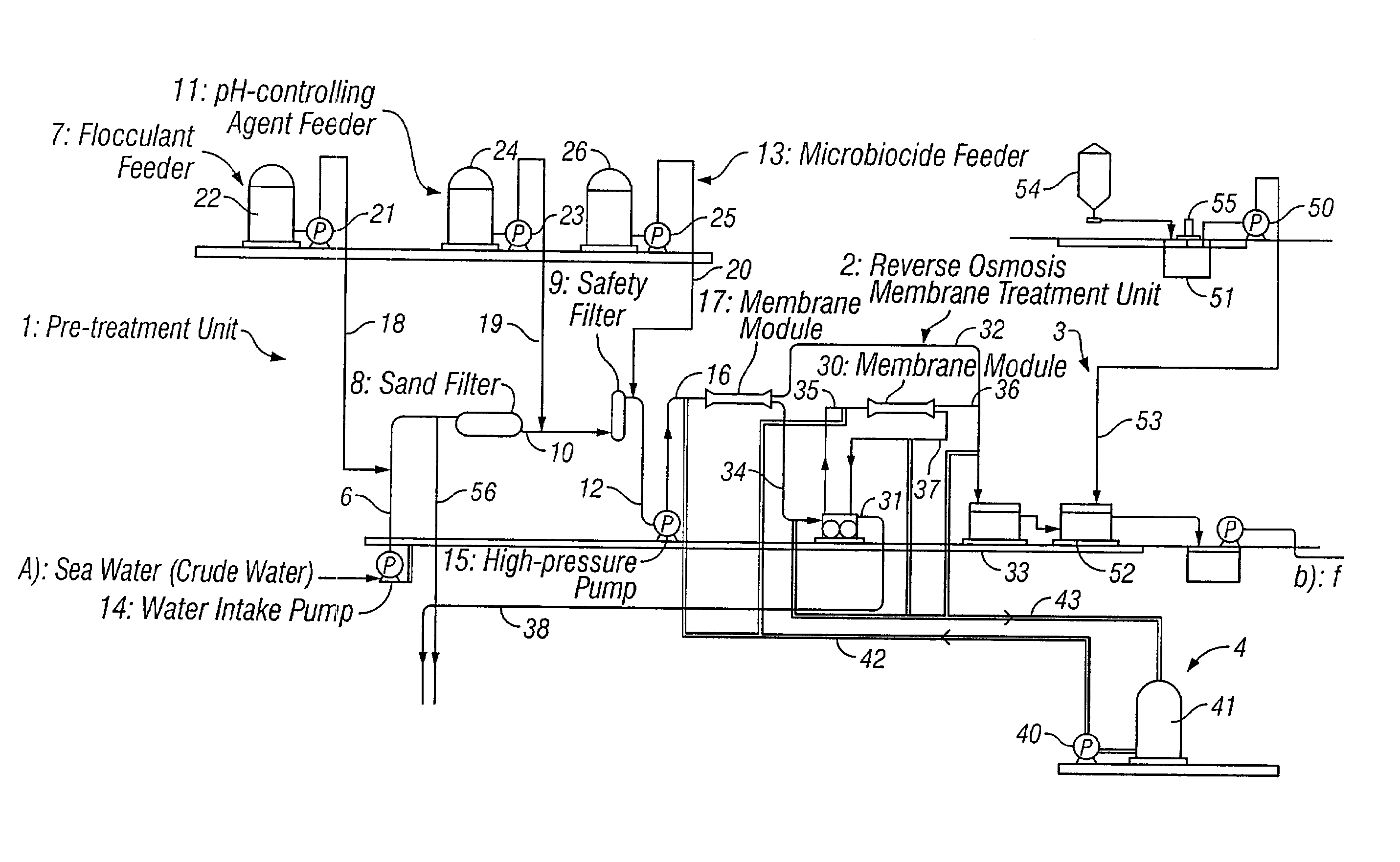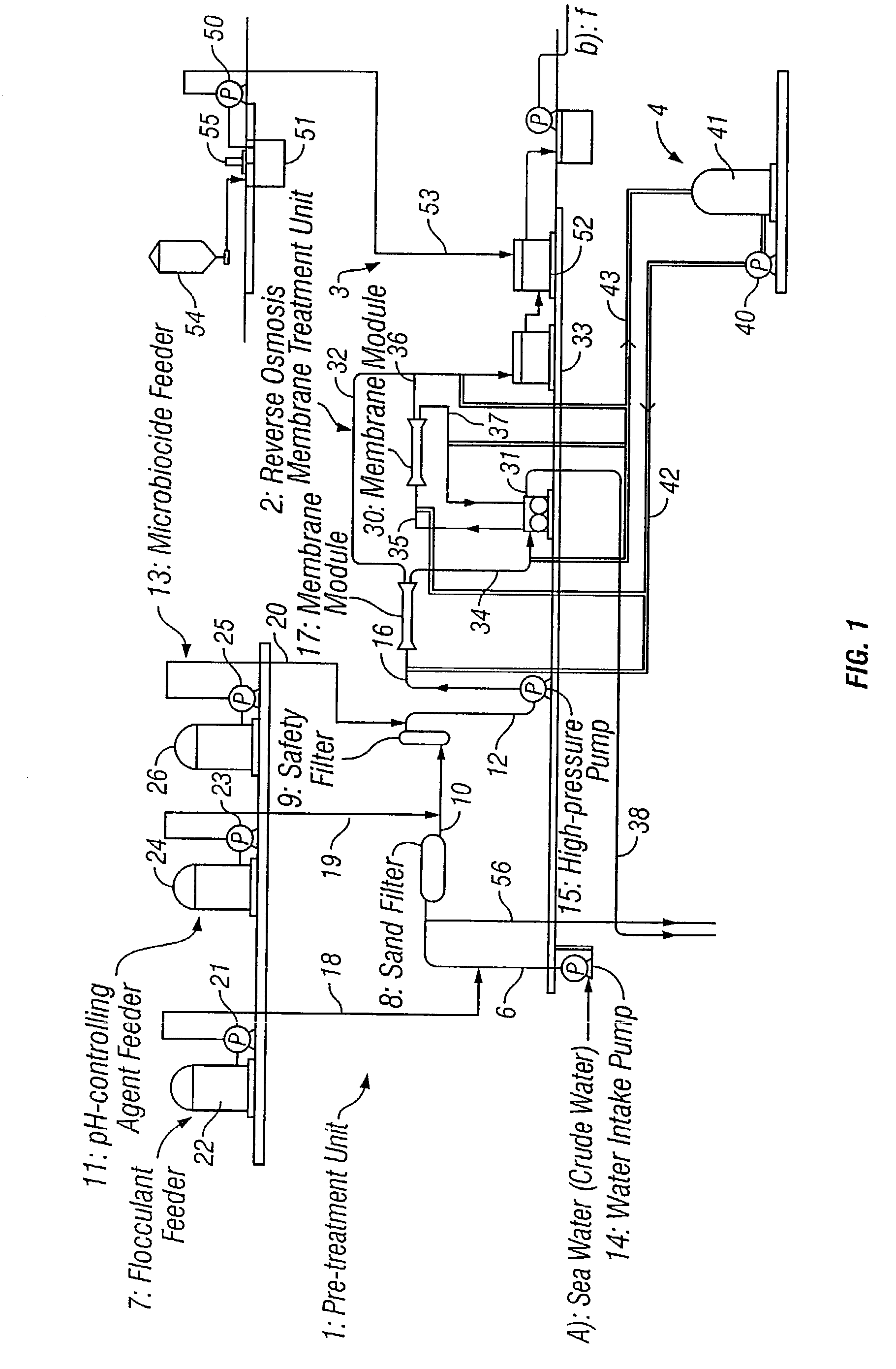Method of bacteriostasis or disinfection for permselective membrane
a technology of permselective membrane and bacteriostasis, which is applied in the direction of membranes, reverse osmosis, separation processes, etc., can solve the problems of reducing the ph value of the water system to such a degree that ordinary bacteria existing therein cannot be killed, and the quality of water is affected, so as to improve the quality of water and increase the membrane pressure
- Summary
- Abstract
- Description
- Claims
- Application Information
AI Technical Summary
Benefits of technology
Problems solved by technology
Method used
Image
Examples
example 1
[0076] Two membrane separation units each having a reverse osmosis membrane of polyamide were driven for seawater desalination through reverse osmosis filtration to produce fresh water. To one of the two units, crude seawater having been pre-treated and subjected to pH control to have a pH of from 3.5 to 4.0 with sulfuric acid added thereto was applied everyday for a period of 30 minutes a day. In that condition, the two units were continuously driven for 1 month. As a result, the pressure loss in the unit to which no sulfuric acid had been added increased, but the pressure loss in the other unit to which sulfuric acid had been added did not change. While the units were driven under the condition, the number of the living cells in the concentrate having passed through each unit was counted. As a result, the number of the living cells in the concentrate in the unit that had been subjected to the sulfuric acid treatment was lowered to 1 / 100 or less, as compared with that of the living...
example 2
[0077] Crude seawater, in which the number of the living cells was 200 cells / ml as counted with an agar plate counter, was applied to a membrane separation unit having a reverse osmosis membrane of polyamide, in which the crude seawater was subjected to reverse osmosis separation. In the pre-treatment unit before the membrane separation unit, a chlorine-containing microbicide was continuously added to the crude seawater so that the remaining chlorine concentration therein could be 1 ppm. Just before the reverse osmosis membrane module in the separation unit, sodium bisulfite was added to the crude seawater being treated. The amount of sodium bisulfite added was so controlled that the remaining sodium bisulfite concentration in the brine to be taken away through the module could be at least 1 ppm. The consumption of sodium bisulfite was 5 ppm in the initial stage. However, after the system was continuously driven for 10 days, the consumption of sodium bisulfite increased up to 35 ppm...
example 3
[0079] Crude seawater, in which the number of the living cells was 200,000 cells / ml as counted with an agar plate counter, was applied to a membrane separation unit having a reverse osmosis membrane of polyamide, in which the crude seawater was subjected to reverse osmosis separation. In the pre-treatment unit before the membrane separation unit, a chlorine-containing microbicide was continuously added to the crude seawater so that the remaining chlorine concentration therein could be at least 1 ppm, and 6 ppm of a de-chlorinating agent of sodium bisulfite was also continuously added thereto. In the membrane separation unit, 500 ppm of sodium bisulfite was added to the crude seawater over a period of 1 hour a week. After the system was driven for about 1 month, the pressure loss in the membrane separation unit increased by about 0.02 MPa, as compared with the initial value.
[0080] The same crude seawater was treated in the same system as above. In this case, however, 1 ppm of the chl...
PUM
| Property | Measurement | Unit |
|---|---|---|
| pH | aaaaa | aaaaa |
| pH | aaaaa | aaaaa |
| pH | aaaaa | aaaaa |
Abstract
Description
Claims
Application Information
 Login to View More
Login to View More - R&D
- Intellectual Property
- Life Sciences
- Materials
- Tech Scout
- Unparalleled Data Quality
- Higher Quality Content
- 60% Fewer Hallucinations
Browse by: Latest US Patents, China's latest patents, Technical Efficacy Thesaurus, Application Domain, Technology Topic, Popular Technical Reports.
© 2025 PatSnap. All rights reserved.Legal|Privacy policy|Modern Slavery Act Transparency Statement|Sitemap|About US| Contact US: help@patsnap.com


